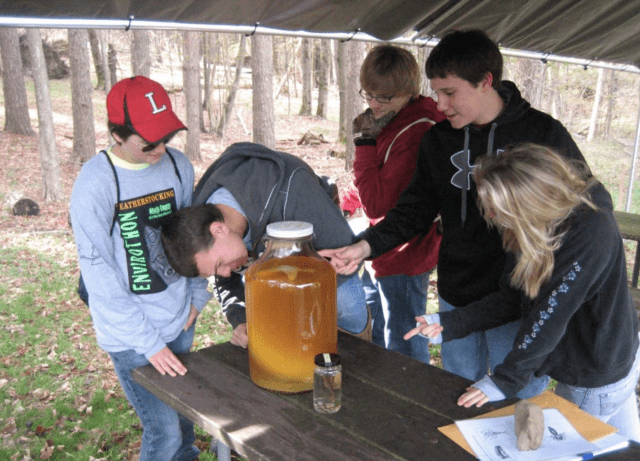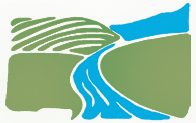 Aquatic Ecology Study Guide
Aquatic Ecology Study Guide
Aquatics or aquatic ecology is the study of animals and plants in freshwater environments. In addition to the many common aquatic species in New York, a student of aquatics learns about watersheds, wetlands and the hydrologic cycle. Essential to understanding and appreciating the field of aquatics is basic knowledge of the physical and chemical properties of water.
Water is arguably the most valuable substance on the planet, and is the common name applied to the liquid state of the hydrogen oxygen compound H2O. It covers 70% of the surface of the Earth forming swamps, lakes, rivers, and oceans. Pure water has a blue tint, which may be detected only in layers of considerable depth. It has no taste or odor. Water molecules are strongly attracted to one another through their two hydrogen atoms. At the surface, this attraction produces a tight film over the water (surface tension). A number of organisms live both on the upper and lower sides of this film.
Density of water is greatest at 39.2° Fahrenheit (4° Celsius). It becomes less as water warms and, more important, as it cools to freezing at 32° Fahrenheit (0° Celsius), and becomes ice. Ice is a poor heat conductor. Therefore, ice sheets on ponds, lakes and rivers trap heat in the water below. For this reason, only very shallow water bodies ever freeze solid.
Water is the only substance that occurs at ordinary temperatures in all three states of matter: solid, liquid, and gas. In its solid state, water is ice, and can be found as glaciers, snow, hail, and frost and ice crystals in clouds. It occurs in the liquid state as water droplets in rain clouds, and on vegetation as dew. Under the influence of gravity, water may accumulate in the openings of hard rock beneath the surface of the earth. This groundwater sustains wells, springs and some streams. As a gas, or water vapor, it occurs as fog, steam, clouds, and humidity.
The transparency of water permits enough light to penetrate for plants to carry on photosynthesis and animals to thrive. The depths to which light can penetrate decrease as water contains more suspended materials and becomes turbid (or less clear). Less light means fewer plants can grow, thus attracting less wildlife.
Our dependence upon water and competition for it have imperiled and will continue to threaten aquatic environments and the organisms living in them. Good water quality is essential for aquatic life as well as for the human species. Recently, the historical emphasis on political entities, such as counties, towns, villages and cities, has shifted to watersheds. It has been said that one-third of the world’s population will experience a water shortage crisis in 2025.
Aquatic Ecology Outline
I. Abiotic Factors
A. Water Cycle
B. Watershed Features
1. Stream Order
2. Stream Health Factors
3. Identify Boundaries
C. Water Conditions
1. Physical
2. Chemical
3. Biological
II. Biotic Factors
A. Energy Flow
B. Carrying Capacity
C. Identify Aquatic Species (Plants, Fish, Amphibians, Micro and Macro Invertebrates)
1. Common
a. Basic Physiology
b. Lifecycles
c. Habitat
2. Rare, Threatened, Endangered
3. Invasive
4. Water Quality indicators
III. Aquatic Environments
A. Wetlands
1. Definition
2. Characteristics
3. Functions/Importance/Values
a. Riparian Zones
c. Aquifers and Groundwater
d. Ponds and Lakes
4. Temperature Zones
5. Vegetation
IV. Water Protection and Conservation
A. Water Quality and Pollution
1. Groundwater
2. Surface Water
B. Types of Pollution
1. Point Source
2. Nonpoint Source
3. Thermal
4. Control methods
C. Management and Legislation
1. Laws
2. Agencies
Learning Objectives
For successful completion of the aquatics section, contestants should be able to:
- Know the processes and phases for each part of the water cycle and understand the water cycle’s role in soil erosion, groundwater recharge, and climatic influences.
- Understand the concept and components of a watershed and be able to identify stream orders and watershed boundaries. Know the features of a healthy watershed and an unhealthy watershed.
- Know how to interpret water and biological quality tests and understand why aquatic organisms and water quality is affected by the physical, chemical and biological conditions of the water and how it impacts aquatic environments.
- Understand the dependence of all organisms on one another and how energy and matter flow within an aquatic ecosystem.
- Understand the concept of carrying capacity for a given aquatic ecosystem, and be able to discuss how water usage may affect the ability of the system to sustain different needs.
- Identify common, rare, threatened and endangered aquatic species as well as aquatic invasive species.
- Identify aquatic and wetland environments based on their physical, chemical and biological characteristics.
- Know characteristics of different types of aquifers, and understand historical trends and threats to groundwater quantity and quality.
- Understand the benefits and ecological functions and values of riparian zones, wetlands and open water systems and be able to identify the associated zone areas.
- Be familiar with both NYS and federal water protection laws and the agencies that enforce those laws. Understand the requirements for required permits.
- Understand concepts and practices to manage non-point source pollution from agricultural, forest and land under development.
- Be familiar with general terminology and definitions pertaining to the subject area.
Aquatic Ecology Sample Questions
Aquatic Ecology Sample Questions
1. A lake ecosystem is termed “phosphorous limited” if:
a. adding nitrogen to the lake causes increased phytoplankton growth
b. adding phosphorus to the lake causes increased phytoplankton growth
c. adding nitrogen to the lake causes decreased phytoplankton growth
d. adding phosphorus to the lake causes decreased phytoplankton growth
e. adding phosphorus to the lake causes no change in phytoplankton growth
2. Pacific salmon (Onchorhyncus spp.) are an example of the “anadromy” life history because they do which of the following:
a. fish spend most of their lives in freshwater and then migrate to the sea for breeding
b. fish spawn in freshwater but juveniles drift back to the ocean where adults spend most of their lives
c. adult female fish die immediately after spawning
d. adults can metamorphose from male to female under high density pressures
e. e. none of the above
3. Which of the following would NOT be considered a benthic macroinvertebrate organism?
a. Diatom
b. Decapod
c. Gastropod
d. Ephemeroptera
e. Bivalvia
4. The water in jar “A” was collected from the surface of a mesotrophic system; the water in jar “B” was collected from the surface of a eutrophic system. What physical parameter should show the greatest difference between these two water samples?
a. Temperature
b. Dissolved oxygen concentration
c. Turbulence
d. Turbidity
e. Salinity
5. Identify the creature making this call by listening to the tape.
a. Wood frog
b. Pickerel frog
c. Spring peeper
d. Green frog
6. If a New York state stream contains a wild trout population then a permit is required to construct a road crossing it. Which of the following agencies would issue the needed permit?
a. United States Fish and Wildlife Service
b. Soil and Water Conservation District
c. New York State Department of Environmental Conservation
d. United States Environmental Protection Agency
e. New York State Department of Transportation
7. Because they produce so much plant biomass and invertebrate life, estuaries and their coastal marshes serve as important nursery areas for the young of many game (recreational) and commercial fish and shellfish. Which of the following fish species is dependent upon coastal wetlands?
a. Brown trout
b. Atlantic chad
c. Northern pike
d. Flounder
8. One of the main functions of a healthy watershed is the temporarily storage and transportation of water from the land surface to the water body. Over time, streams develop into defined drainage networks. Which of the following is not a recognized drainage pattern?
a. Parallel
b. Spiral
c. Angular
d. Dendritic
Aquatics Ecology References
Abiotic Factors
Water Science Basics, Watershed, Stream Classisfication, Stream Geomorphology
Biotic Factors
Primers for Aquatic Plants, Pond Stream, Eurasian Watermilfoil
Aquatic Environments
Threats to Wetlands, Wetland Types, Types of Wetland, Wetland Functions, Protecting Wetlands for Amphibians and Reptile, Lacustine, Palustine, Ranks Glossary, Riverine, Terrestrial System, Aquifers, Groundwater
Water Protection and Conservation
Urban Runoff Fact Sheet, Managing NPS from Agriculture, Managing NPS from Households, Clean Water Act, Wetland Regulation Authority
Additional Resources:
Aquatic Ecology
Aquatic Plants, Vegetation & Algae, Control Methods for Aquatic Plants, Identifying and Managing Aquatic Vegetation , Lake Ecology
Non Point Source Pollution
Guide for Establishing Riparian Buffers
Macro Invertebrates
Macroinverebrate Dichotomous Key, Macro Invertebrates
Website References
North America Native Fishes Association
NatureNorth.com
Cortland Herpetology Connection
USDA Aquatic and Invasive Plants

